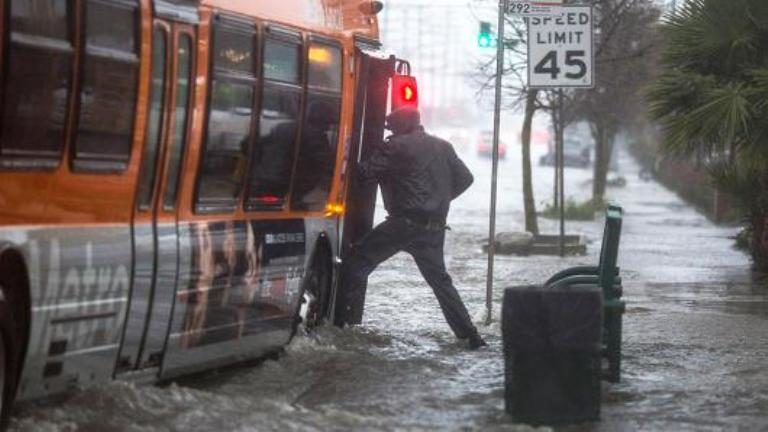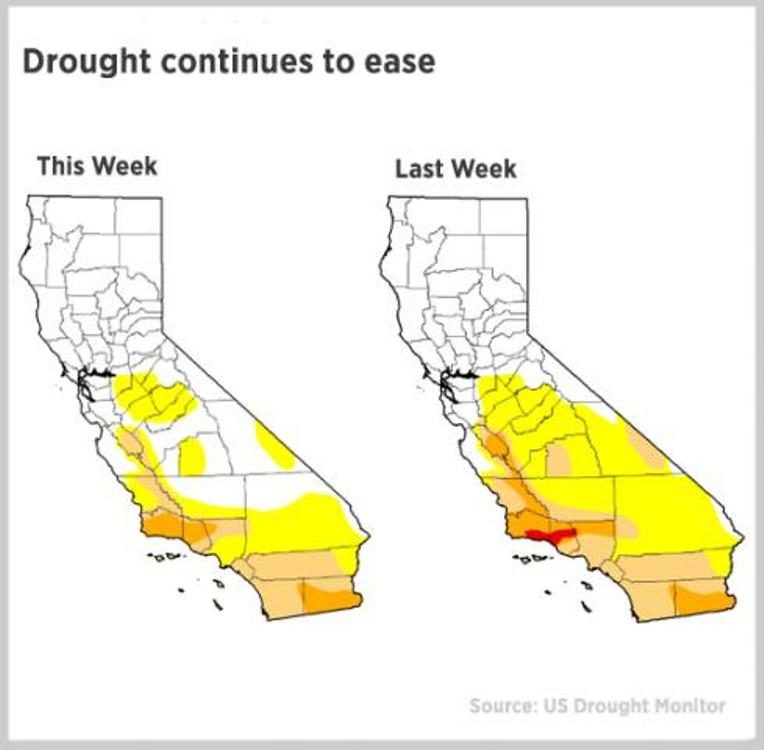
Also, the state's Central Valley region where agriculture is dominant continued to show improvement from abnormally dry conditions.
"The precipitation that fell this week continued to reduce long-term drought in California," the monitor said Thursday. "Santa Barbara and Ventura Counties, which have been the epicenter of drought in California in recent weeks, received much-needed rainfall."
The monitor said more than 8 inches of rain was reported at two stations near Santa Barbara and almost 7 inches nearby at Ojai. Ventura County's community of Thousand Oaks also experienced well over 6 inches of rain.
"It's been raining a lot and gone a tremendous way towards eliminating surface drought conditions in California," said Richard Heim, a meteorologist with National Oceanic and Atmospheric Administration 's National Centers for Environmental Information and the author of this week's monitor.
Added Heim, "We felt it was time that the extreme drought [category] went away." He said this week's monitor is the first time since Aug. 6, 2013, that California is free of "extreme" drought conditions.
The worst drought condition in the state now is "severe" drought but only 4 percent of the state is classified in that category in this week's monitor. That's down from just over 7 percent of the state in severe drought last week and 60 percent three months ago.
Santa Barbara County, located along the state's coast, has been one of the last holdouts of the drought. Conditions have been so dire that the city of Santa Barbara has been making plans to reopen a mothballed desalination plant to turn seawater into drinking water.
The latest storm brought welcome water for the Santa Barbara region, particularly to its Lake Cachuma — historically a major source of water for the area.
"Streams were running full, which helped refill depleted reservoirs in the area," monitor said. "Lake Cachuma rose 24 feet in just one day, which is remarkable and most welcomed."
The L.A. area also was a major beneficiary of the rains, with some communities receiving upwards of 6 inches of rainfall in 24 hours on Friday. The heavy rain resulted in some flooding to streets and major freeways, forcing more than a dozen people to be rescued and several weather-related fatalities in Southern California.
Even so, the monitor said the reservoirs in parts of Southern California "still have a long way to go before we can classify this area as drought-free. As of February 22, Lake Cachuma was at 82,011 acre-feet, or 42.4 percent of capacity, Jameson Reservoir was at 52.5 percent capacity, Lake Casitas at 42.3 percent, and Lake Piru at 31.7 percent. These values still represent a significant hydrological drought."
Overall, this week's monitor showed "moderate" drought conditions remain in about 38 percent of the state, but that's down sharply from 56 percent last week. The moderate drought areas, shown in light orange on the monitor map, continue in small portions of the state's Central region as well as portions of Southern California.
The "severe" drought conditions, shown in bright orange on the monitor map, continue in Santa Barbara, Ventura and portions of Los Angeles counties, as well as some areas near the U.S.-Mexico border.
The latest monitor map for the state shows "extreme" drought (shown in red) is completely gone from portions of Southern California; last week's monitor showed there was still nearly 1 percent of the southern region in the second-worst drought condition.
Elsewhere, the Northern California region also experienced heavy rain and snow from the recent storms, with some areas getting more than a foot of precipitation. Northern California has been essentially drought free for several weeks, pulled out of the dire conditions by significant rains from January storms.
The deluge of rain produced major flooding in some large cities, including San Jose where about 14,000 residents in low-lying areas were forced to evacuate this week when Santa Clara County's Anderson Reservoir filled up and caused Coyote Creek to overflow.
This storm marked the first time since 2006 that Anderson Reservoir's spillway activated, producing heavy outflows that the San Francisco Chronicle likened to Niagara Falls.
The recent storms also have blanketed the Sierra Nevada mountain range with more snow.
As of Feb. 21, the monitor said the daily Sierra Nevada snowpack was 186 percent of average for the date and 151 percent of the April 1 climatological peak. That is significant since the snowpack supplies about 30 percent of California's water particularly in the spring and summer months.
A new storm was forecast to reach California over the weekend, according to the National Weather Service. Rain was forecast to continue into Monday, and the cold storm also was expected to bring more snow to the Sierra mountains.




Comment: The recent Oroville dam crisis is a wake up call for the aging California water system.